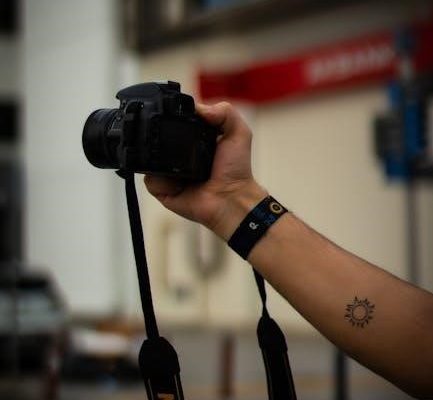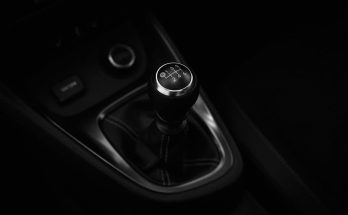The Nikon D40X is a 10․2-megapixel DSLR camera designed for entry-level photographers, offering user-friendly controls and advanced features․ Its manual provides detailed guidance on camera functions, settings, and techniques․
Key Features of the Nikon D40X
The Nikon D40X boasts a 10․2-megapixel CCD sensor, ensuring high-quality images with excellent detail․ It features a 3x optical zoom lens, providing versatility for various shooting scenarios․ The camera supports ISO sensitivity up to 1600, allowing for low-light photography․ Equipped with Nikon’s EXPEED image processing engine, it delivers enhanced image quality and faster performance․ The D40X also offers a 2․5-inch LCD screen for previewing and reviewing shots․ Its built-in flash and compatibility with external Speedlights expand lighting options․ The camera supports RAW image capture and features 11 autofocus points for precise subject tracking․ With a burst mode of up to 3 frames per second, it’s ideal for capturing action shots․ The D40X is compatible with a wide range of Nikon F-mount lenses, offering flexibility for photographers․ Its ergonomic design and intuitive controls make it user-friendly, while the long-lasting battery life ensures extended shooting sessions․ Firmware updates are also supported for improved functionality․
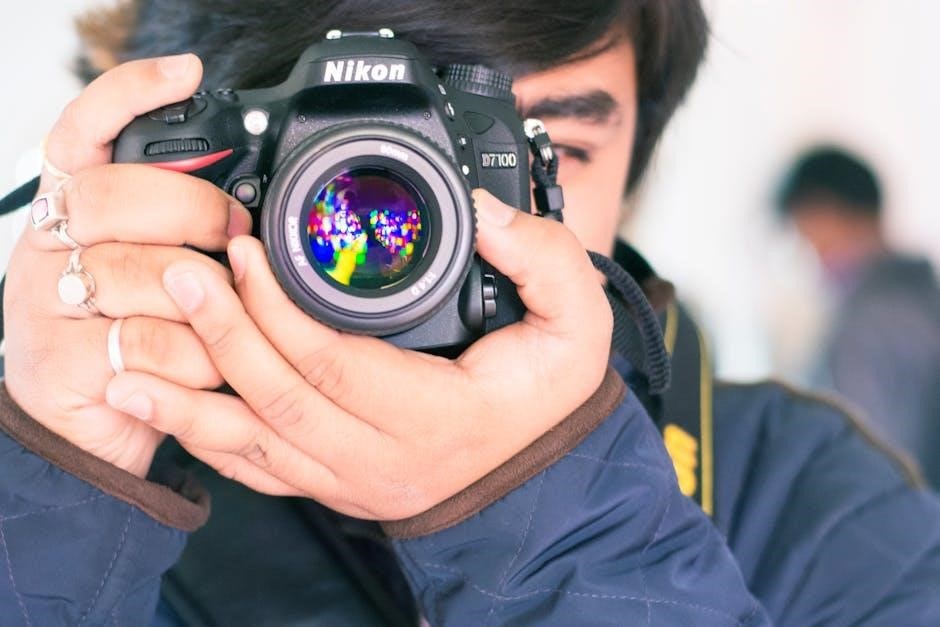
Camera Controls and Layout
The Nikon D40X features intuitive controls, including a mode dial and shutter button on the top, with rear buttons for navigation, playback, and menu access, ensuring easy operation․
3․1 Top of Camera Controls
The top of the Nikon D40X houses essential controls for quick access․ The shutter button is centrally located, surrounded by the zoom control for adjusting focal length․ On the top-right, the mode dial allows switching between various shooting modes like Auto, Program, Shutter Priority, Aperture Priority, and Manual․ Adjacent to it is the exposure compensation button, enabling adjustments to brightness without diving into menus․ A hot shoe is also present for attaching external flash units, enhancing lighting capabilities․ These controls are ergonomically placed, ensuring intuitive operation during shooting sessions․ The layout facilitates seamless navigation, making it easier for photographers to focus on capturing moments rather than fumbling with settings․
3․2 Rear Controls and Buttons
The rear of the Nikon D40X features a comprehensive set of controls designed for easy navigation․ The 2․5-inch LCD monitor dominates the back, providing a clear preview and review of images․ To its right, the multi-selector allows for menu navigation and focus point selection․ Above it, the delete button enables quick removal of unwanted images․ The playback button lets users review photos, while the menu button grants access to the camera’s extensive settings․ Below, the okay button confirms selections, and the zoom buttons (magnify and reduce) aid in image review․ These controls are strategically positioned to enhance workflow efficiency, ensuring that photographers can quickly adjust settings or review their work without missing a shot․ The logical layout of these buttons simplifies the learning curve, making the camera accessible to both beginners and experienced users․
3․3 Additional Buttons and Functions
Beyond the primary controls, the Nikon D40X includes several additional buttons that enhance functionality․ The Fn (Function) button is customizable, allowing users to assign preferred settings like ISO sensitivity or white balance for quick access․ Located near the grip, the BKT (Bracketing) button enables exposure bracketing, useful for capturing a series of images at varying exposures․ The Metering Mode button, positioned near the shutter release, lets users switch between metering modes such as Matrix, Center-Weighted, and Spot metering․ These buttons are designed to streamline workflows, providing rapid access to essential settings․ Additionally, the AE-L/AF-L button locks exposure and focus, ensuring consistency across shots․ These extra controls add versatility, catering to both casual and advanced photographers․ By understanding these buttons, users can optimize their shooting experience, making the D40X a powerful yet user-friendly camera for diverse photography needs․
Shooting Modes Explained
The Nikon D40X offers multiple shooting modes, including Auto, Program, Shutter Priority, Aperture Priority, Manual, and Scene modes, catering to both beginners and advanced photographers’ needs effectively․
4․1 Auto Mode
The Auto Mode on the Nikon D40X is designed for simplicity, making it ideal for beginners or quick shooting situations․ In this mode, the camera automatically adjusts exposure, ISO, and autofocus settings to deliver well-balanced images․
The D40X’s Auto Mode minimizes manual intervention, allowing users to focus solely on composition and capturing moments․ It is particularly useful for casual photography, such as family gatherings or travel, where time is limited․
While Auto Mode limits creative control, it ensures consistent results by optimizing settings for various lighting conditions․ The camera also activates features like Active D-Lighting to enhance image quality by improving contrast and detail in shadows and highlights․
For users new to DSLR photography, Auto Mode serves as a great starting point before transitioning to more advanced modes like Program, Aperture Priority, or Manual․ It provides a seamless introduction to the camera’s capabilities while maintaining ease of use․
4․2 Program Mode (P)
Program Mode (P) on the Nikon D40X offers a balance between convenience and customization, making it a versatile option for photographers․ In this mode, the camera automatically selects both aperture and shutter speed to ensure proper exposure․
However, unlike Auto Mode, Program Mode allows users to adjust settings such as exposure compensation, ISO sensitivity, and white balance to fine-tune their results․ This flexibility is ideal for photographers who want to influence the outcome without manually managing all parameters․
The D40X’s Program Mode is particularly useful in changing lighting conditions, where the camera can adapt quickly while still enabling creative input․ It serves as a stepping stone for photographers transitioning from fully automatic modes to more advanced shooting techniques․
By combining ease of use with adjustable settings, Program Mode provides a practical and efficient way to capture high-quality images while maintaining control over key aspects of photography․
4․3 Shutter Priority Mode (S)
Shutter Priority Mode (S) on the Nikon D40X allows photographers to manually set the shutter speed while the camera automatically adjusts the aperture for optimal exposure․
This mode is particularly useful for capturing motion, enabling users to freeze fast-moving subjects or create artistic motion blur․ By adjusting the shutter speed, photographers can control the visual effects of movement in their images․
The D40X simplifies the process with its intuitive controls, making it easy to select the desired shutter speed using the command dial․ The camera then calculates the appropriate aperture to maintain the correct exposure․
Shutter Priority Mode is ideal for situations like sports photography, where freezing action is crucial, or for creative effects in low-light conditions․ It provides a balance of control and automation, making it a versatile option for photographers looking to experiment with motion and lighting effects;
4․4 Aperture Priority Mode (A)
Aperture Priority Mode (A) on the Nikon D40X lets users manually set the aperture value while the camera adjusts the shutter speed automatically for proper exposure․
This mode is essential for controlling the depth of field, enabling photographers to isolate subjects or ensure more of the image is in focus․ A smaller aperture (higher f-stop) sharpens the background, while a larger aperture (lower f-stop) blurs it․
The D40X’s intuitive interface allows easy aperture adjustments using the command dial․ The camera then selects the appropriate shutter speed to maintain the correct exposure, offering a balance of creative control and automation․
Aperture Priority Mode is ideal for portrait photography, where a shallow depth of field is desired, or for landscapes requiring a large depth of field․ It empowers photographers to achieve precise control over their images’ aesthetic appeal․
4․5 Manual Mode (M)
Manual Mode (M) on the Nikon D40X provides full creative control, allowing users to manually set both the aperture and shutter speed․ This mode is ideal for photographers who want precise control over their settings to achieve specific artistic effects․ In Manual Mode, the camera does not automatically adjust any settings, giving users complete freedom to experiment․ The D40X’s built-in light meter assists in determining the correct exposure by displaying a scale in the viewfinder or on the LCD screen․ Users can adjust the aperture using the command dial and the shutter speed via the shutter-release button dial․ This mode is particularly useful in challenging lighting conditions or when a specific visual outcome is desired․ It is best suited for experienced photographers who understand how aperture, shutter speed, and ISO interact to produce the desired image․ Manual Mode offers the ultimate flexibility for creative photography․
4․6 Scene Modes
The Nikon D40X offers a variety of Scene Modes designed to simplify shooting in common scenarios․ These modes automatically adjust camera settings to optimize results for specific situations․ Portrait Mode softens backgrounds to emphasize subjects, while Landscape Mode ensures sharpness and vibrant colors for distant scenes․ Sports Mode freezes fast-moving subjects, and Night Portrait Mode balances flash with ambient light for low-light portraits․ Close-Up Mode enhances detail in macro photography, and Night Landscape Mode captures cityscapes or starry skies with reduced noise․ These modes are accessed via the mode dial and provide easy solutions for photographers who want professional-looking results without manual adjustments․ Scene Modes are ideal for beginners or those who prefer convenience while still achieving high-quality images․ They offer a great way to explore different photography styles without the complexity of manual controls․
Custom Settings and Configuration
The Nikon D40X allows users to customize camera settings to suit their preferences, offering flexibility for both beginners and advanced photographers․ The Custom Settings menu provides options to adjust various functions, such as autofocus, metering, and exposure settings․ Users can modify default settings to optimize performance for specific shooting styles․ For example, Active D-Lighting can be enabled to enhance detail in high-contrast scenes, while image sharpening and noise reduction can be fine-tuned for desired results․ Additionally, the camera supports customizing the AE-L/AF-L button and other controls, allowing for a more personalized shooting experience․ These configurations enable photographers to tailor the camera’s behavior to their creative vision․ The D40X’s custom settings are detailed in the user manual, providing a comprehensive guide for advanced users seeking to optimize their camera’s performance․ This feature-rich system ensures versatility and enhances the overall photography experience․
White Balance and Color Settings
The Nikon D40X offers a range of white balance options to ensure accurate color representation in various lighting conditions․ Users can select from Auto, Daylight, Fluorescent, Incandescent, Flash, and Cloudy modes․ Additionally, the camera allows for fine-tuning white balance settings to match specific lighting environments․ The Custom White Balance option enables users to set a precise white balance by capturing a reference image of a neutral object․ This feature is particularly useful for achieving consistent colors in controlled lighting setups․ The D40X also supports color settings such as Vivid, Neutral, and Monochrome, allowing photographers to tailor the color output to their creative preferences․ These settings can be adjusted via the camera’s menu system, providing flexibility for both casual and professional photography․ The user manual provides detailed instructions on how to access and customize these options for optimal results․ Proper use of white balance and color settings enhances image quality and ensures vibrant, true-to-life colors․
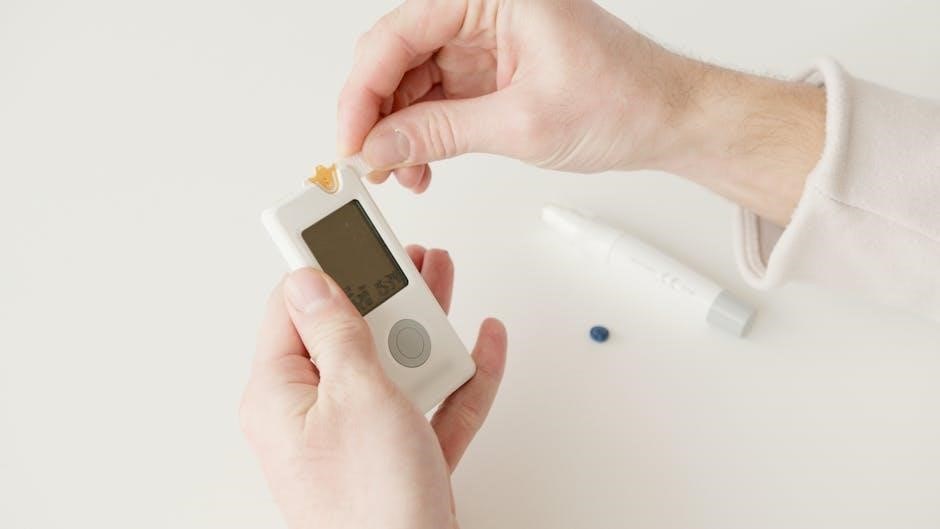
ISO Sensitivity and Noise Reduction
The Nikon D40X features an ISO sensitivity range of 100 to 1600, allowing photographers to capture images in a variety of lighting conditions․ The camera’s noise reduction system helps minimize grain, particularly in low-light shots․ Users can adjust ISO settings manually or rely on the camera’s Auto ISO mode, which automatically selects the optimal sensitivity based on the scene․ For better control, the D40X also offers High ISO Noise Reduction, which can be enabled or disabled depending on the user’s preference․ This feature is especially useful for reducing digital noise in images shot at higher ISO levels․ The camera’s noise reduction algorithms work effectively to preserve detail while maintaining image clarity, ensuring high-quality results even in challenging lighting environments․ Proper use of ISO and noise reduction settings enhances the overall image quality and versatility of the D40X․
Focus Modes and AF Settings
The Nikon D40X offers three primary focus modes: Single AF, Continuous AF, and Manual Focus․ Single AF is ideal for stationary subjects, locking focus once the shutter is pressed halfway․ Continuous AF is designed for moving subjects, adjusting focus continuously until the image is captured․ Manual Focus allows precise control for creative or challenging situations․ The camera also features AF Area Modes, including Single Servo AF and Dynamic Area AF, which help track subjects within the frame․ Users can customize AF settings, such as AF sensitivity and focus priority, to suit their shooting style․ The D40X’s AF system is quick and accurate, ensuring sharp images in various conditions․ By adjusting these settings, photographers can optimize focus performance for their specific needs․ The user manual provides detailed guidance on configuring and using these features effectively․ Proper use of focus modes enhances overall image sharpness and clarity․
Metering Modes Explained
The Nikon D40X features three metering modes to ensure accurate exposure: 3D Color Matrix II, Center-Weighted, and Spot Metering․ The 3D Color Matrix II mode is the default, using advanced algorithms to analyze brightness, color, and composition for balanced results․ It’s ideal for most shooting scenarios․ Center-Weighted metering prioritizes the central area of the frame, making it suitable for portraits or when the subject is centered․ Spot Metering measures light from a small area (about 3․5% of the frame), allowing precise control for high-contrast scenes or backlit subjects․ The user manual provides detailed instructions on selecting and using these modes effectively․ By understanding and applying these metering options, photographers can achieve consistent and precise exposures, enhancing their creative control over images․ Proper use of metering modes is essential for capturing accurately lit photos in various lighting conditions․
Memory Cards and Storage Options
The Nikon D40X supports SD and SDHC memory cards, with a maximum capacity of 4GB for SD and 8GB for SDHC․ The camera does not support SDXC cards․ For optimal performance, it’s recommended to use high-speed memory cards with a Class 6 rating or higher, especially when shooting in burst mode or recording large files․ The D40X allows users to format memory cards directly in the camera, ensuring proper initialization and preventing potential issues․ Always format new cards in the camera before use to maintain compatibility and performance․ Using high-quality memory cards is essential for reliable image storage and smooth camera operation․ Refer to the user manual for detailed instructions on card formatting and storage best practices․ Proper memory card management ensures your photos and videos are safely stored and easily accessible․
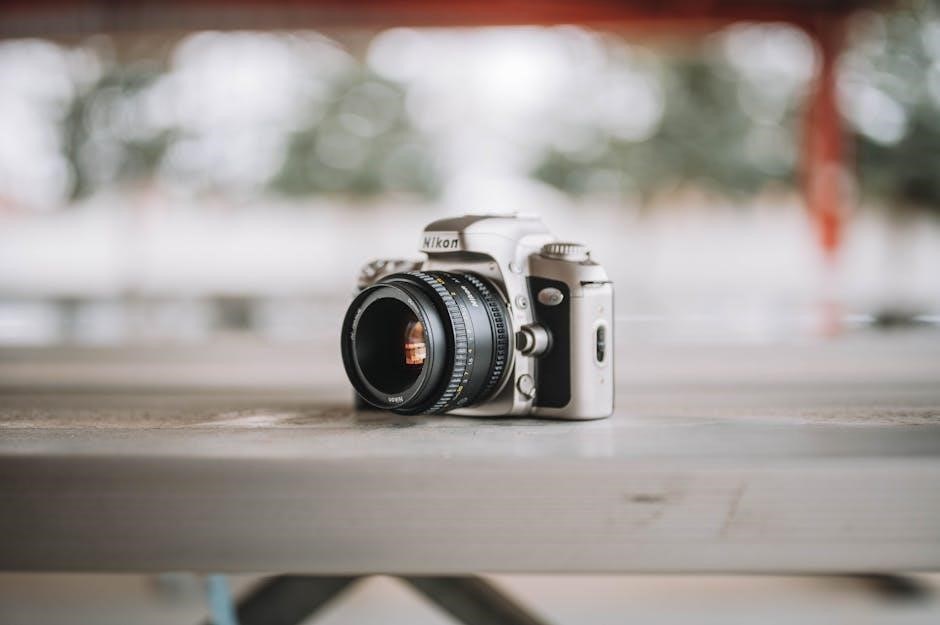
Playback and Review Options
The Nikon D40X features a 2․5-inch LCD screen for reviewing images, allowing users to easily navigate and view captured photos․ The camera offers options to zoom in on images for detailed examination using the + and ‒ buttons․ Users can also delete unwanted photos directly during playback or protect images to prevent accidental deletion․ Additionally, the D40X supports slide show playback, enabling users to review their photos in a sequential manner․ The playback menu provides options to customize review settings, such as image interval and transition effects․ This feature enhances the overall user experience by making photo review intuitive and engaging․ The ability to rotate images and adjust brightness during playback further adds to the camera’s versatility․ These options make the Nikon D40X a user-friendly device for photographers of all skill levels․

Navigating the Menu System
Navigating the Nikon D40X menu system is straightforward, with options organized into logical categories․ The multi-selector on the rear of the camera allows users to scroll through menu items, while the OK button confirms selections․ The menu is divided into sections such as Shooting Menu, Playback Menu, and Setup Menu, each containing specific camera settings․ Users can customize options like white balance, ISO sensitivity, and autofocus modes․ The My Menu feature enables users to save frequently used settings for quick access․ Additionally, the camera provides a help button that offers brief explanations of menu items․ This intuitive design ensures that users can efficiently adjust settings without confusion․ The menu system is also customizable, allowing photographers to tailor the interface to their preferences․ This flexibility makes the Nikon D40X user-friendly for both beginners and advanced photographers․
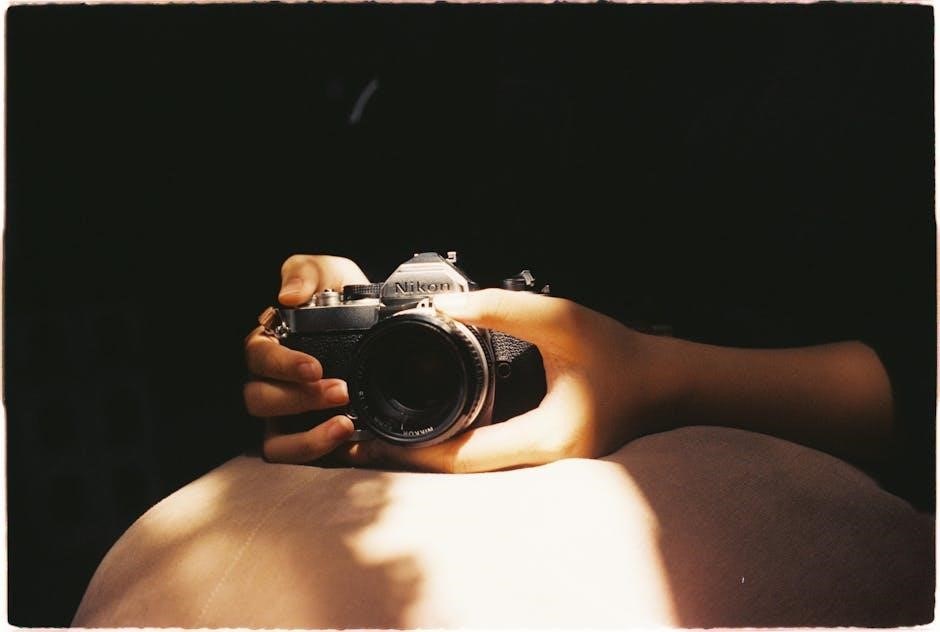
Battery and Power Management
The Nikon D40X uses the EN-EL9 lithium-ion battery, providing approximately 520 shots per charge under normal conditions․ The included MH-23 charger fully charges the battery in about 2 hours․ To extend battery life, users can enable the Auto-off feature, which powers down the camera after a period of inactivity․ Additionally, the D40X includes a power-saving mode that reduces battery consumption when the camera is not in use․ For extended shooting sessions, optional MB-D40 battery grips can be used to double the camera’s battery capacity․ It is recommended to use genuine Nikon batteries for optimal performance and longevity․ Proper storage and care of the battery, such as avoiding extreme temperatures, will also help maintain its capacity over time․ This ensures reliable power management for photographers․
Lens Compatibility and Mount
The Nikon D40X features the F-mount, ensuring compatibility with a wide range of Nikon lenses․ It supports AF-S, AF, and AI lenses, though some older lenses may require manual focus․ The camera is compatible with DX-format lenses, which are optimized for its APS-C sensor, as well as FX-format lenses in a cropped mode․ Using non-CPU lenses is possible but with limited functionality․ The AF-I and AF-D lenses work seamlessly, while AI-P lenses may require manual metering․ The built-in lens metering system ensures accurate exposure with compatible lenses․ For enhanced versatility, the D40X supports teleconverters and other accessories via the F-mount․ Always use genuine Nikon lenses for optimal performance and image quality․ This compatibility makes the D40X adaptable for various photography needs․ Proper lens maintenance is essential for maintaining image clarity and camera functionality․
Accessories for the Nikon D40X
The Nikon D40X can be enhanced with a variety of accessories to improve functionality and usability․ The MB-D80 battery grip extends shooting sessions, while the EH-5a AC adapter provides a reliable power source․ For storage, the CF memory cards are recommended, with high-speed options ideal for continuous shooting․ The Nikon Speedlight SB-400 offers additional lighting control, and the MC-DC1 remote release minimizes camera shake․ Protective gear like the CF-DA10 loupe and NB-3AH battery pack are also available․ The Nikon Capture NX software enhances post-processing, while the AN-4Y strap offers comfort during extended use․ These accessories ensure the D40X meets diverse photography needs, from casual to professional use․ They are designed to integrate seamlessly with the camera, ensuring optimal performance and convenience․
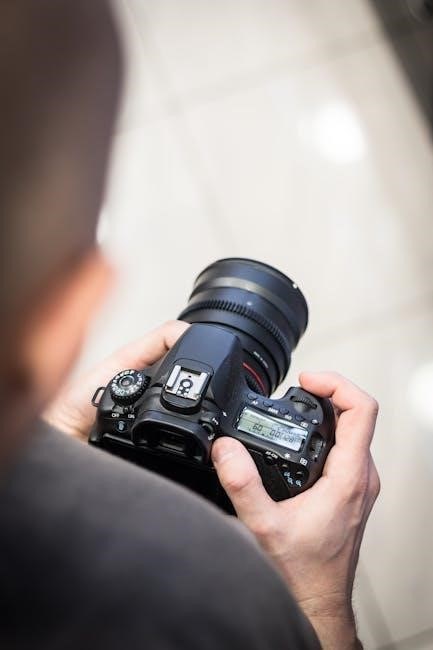
Maintenance and Care Tips
Proper maintenance ensures the Nikon D40X performs optimally and lasts longer․ Regularly clean the camera body and lenses with a soft cloth and avoid harsh chemicals․ Use a microfiber cloth to wipe the LCD screen gently․ For the image sensor, activate the Clean Image Sensor function in the menu or use a manual cleaning brush․ Store the camera in a dry, cool place to prevent moisture damage․ Avoid exposure to extreme temperatures or humidity․ Clean the battery contacts with a dry cloth to maintain power performance․ Update firmware periodically to ensure all features function correctly․ For lenses, use a UV filter to protect against dust and scratches․ Avoid touching the sensor or mirror to prevent smudges․ Use a silica gel packet in the camera bag to absorb moisture․ Regularly format memory cards to maintain data integrity․ These simple steps help preserve the camera’s functionality and image quality over time․
Firmware Updates and Software
Keeping your Nikon D40X up-to-date with the latest firmware ensures optimal performance and compatibility․ Firmware updates can improve camera functionality, fix bugs, and enhance security․ To update, visit Nikon’s official website, download the latest firmware version, and follow the installation instructions carefully․ Always use a fully charged battery or a power adapter to avoid interruptions during the update process․ After updating, verify the firmware version in the camera menu to confirm success․ Additionally, Nikon provides software tools like ViewNX and Capture NX for image editing and management․ These programs can be downloaded from Nikon’s website and are compatible with the D40X․ Regularly updating both firmware and software ensures you have access to the latest features and improvements for your camera․
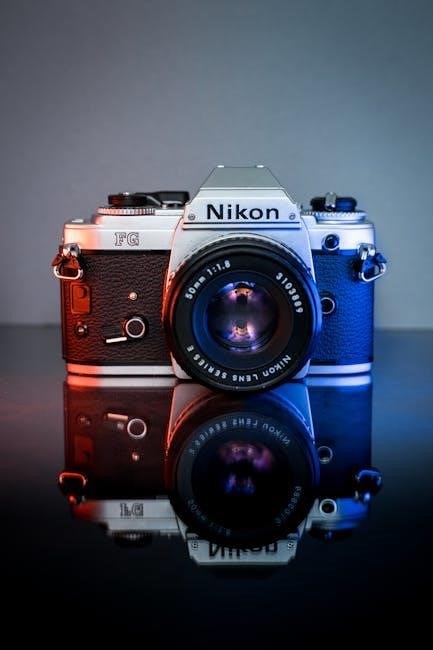
Troubleshooting Common Issues
Troubleshooting common issues with the Nikon D40X can help resolve problems quickly․ One frequent issue is the “ERR” error message, which indicates a problem with the camera’s internal system․ Restarting the camera or resetting it to factory settings often resolves this․ Another common issue is memory card errors, which can be fixed by formatting the card in the camera or using a card reader․ If the LCD screen appears blank, check the brightness settings or ensure the monitor is turned on․ For focus issues, clean the lens and ensure autofocus is enabled․ If problems persist, refer to the user manual or contact Nikon support for assistance․ Regular maintenance and updates can help prevent these issues from arising․
Nikon D40X vs Other Models
The Nikon D40X stands out among its counterparts due to its 10․2-megapixel sensor and enhanced burst mode․ Compared to the Nikon D40, it offers higher resolution and improved continuous shooting․ The Nikon D80, while similar in design, features a larger LCD and more advanced autofocus, making it a step up for professionals․ The Nikon D60 introduced Scene Recognition and a more intuitive interface, appealing to casual users․ Meanwhile, the Nikon D90 advanced further with HD video recording, setting a new standard․ Each model caters to different needs, with the D40X balancing quality and affordability, making it a versatile choice for enthusiasts seeking a balance between performance and budget․
Advanced Shooting Techniques
Mastering advanced techniques with the Nikon D40X enhances your photography skills․ High Dynamic Range (HDR) photography can be achieved by bracketing exposures and merging images in post-processing․ Panning creates dynamic motion blur, ideal for capturing moving subjects like wildlife or vehicles․ Experiment with slow shutter speeds to add artistic effects, such as waterfalls or light trails․ For precise control, use manual focus and adjust settings like aperture and shutter speed to optimize depth of field and lighting․ Shooting in RAW format allows greater flexibility in editing, preserving image details․ Utilize the camera’s built-in histogram to ensure proper exposure․ These techniques, combined with practice, will elevate your photography to professional levels and unlock the full potential of the Nikon D40X․
The Nikon D40X is a versatile and user-friendly DSLR that caters to both beginners and enthusiasts․ Its intuitive controls and advanced features make it an excellent choice for capturing high-quality images․ The camera’s lightweight design and ergonomic layout ensure comfort during extended shooting sessions․ With its impressive 10․2-megapixel sensor and wide range of manual controls, the D40X offers flexibility for creative photography․ The availability of detailed user manuals and guides further enhances the learning experience for new users․ Whether you’re shooting landscapes, portraits, or action photos, the Nikon D40X delivers consistent results․ Its compatibility with a wide range of lenses and accessories also makes it a great long-term investment․ Overall, the Nikon D40X remains a reliable and feature-rich DSLR that continues to meet the needs of photographers at various skill levels․
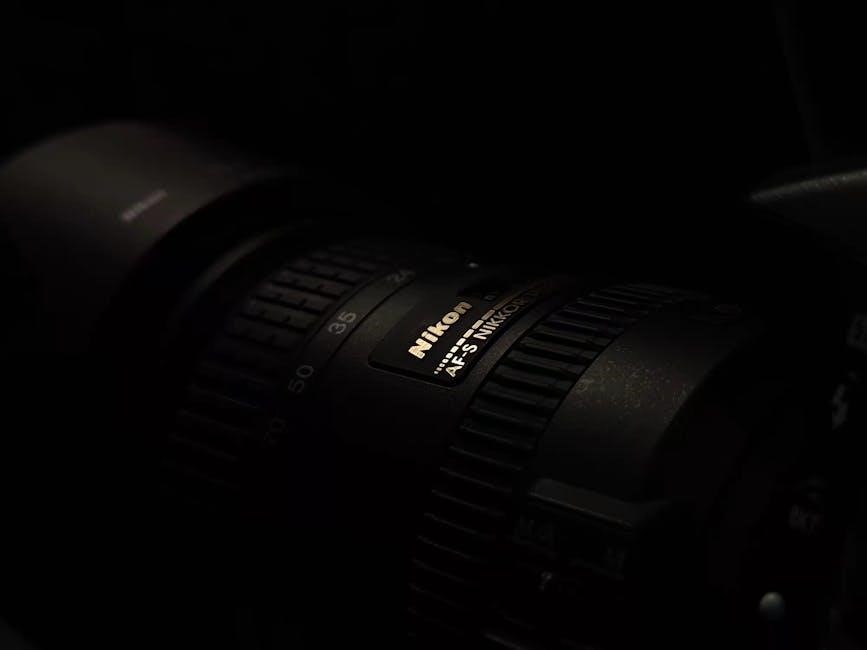
Additional Resources and Downloads
For further learning and customization, Nikon offers a variety of resources for the D40X․ The official Nikon website provides downloadable user manuals, firmware updates, and software tools․ Users can access the full user manual in PDF format, which covers all camera functions and settings in detail․ Additional resources include guides for Nikon’s Image Space, Camera Control Pro, and other compatible software․ Firmware updates ensure the camera operates at its best, while software tools enhance post-processing capabilities․ Nikon also provides instructional videos and tutorials on their website․ For troubleshooting, Nikon’s support page offers FAQs and repair service information․ These resources help users maximize their D40X experience, whether they’re beginners or advanced photographers․ All downloads are available directly from Nikon’s official website, ensuring reliability and compatibility․
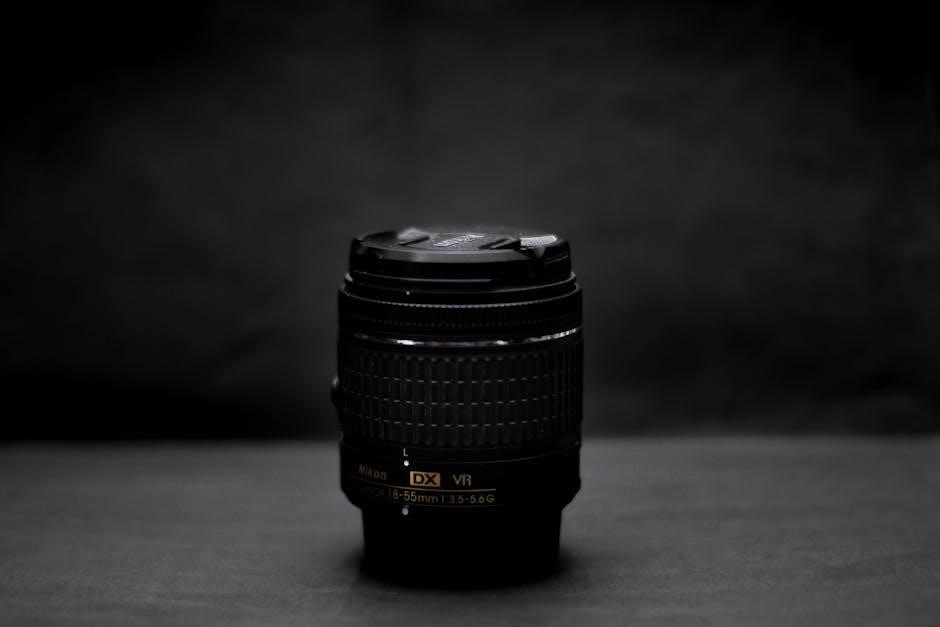
FAQs and Common Questions
Here are some frequently asked questions about the Nikon D40X:
- Where can I download the Nikon D40X user manual? The manual is available on Nikon’s official website or through authorized dealers․
- How do I update the firmware? Visit Nikon’s support page, download the latest firmware, and follow the on-screen instructions․
- What lenses are compatible with the D40X? It supports Nikon F-mount lenses, including AF-S, AF, and AI lenses․
- What is the maximum ISO sensitivity? The D40X offers ISO sensitivity up to 1600․
- Can I use external flashes? Yes, the D40X supports external flashes via the hot shoe mount․
These FAQs address common queries to help users get the most out of their Nikon D40X․
User Manual Download and Availability
The Nikon D40X user manual is readily available for download from Nikon’s official website and other authorized sources․ The manual is provided in PDF format, making it easy to access and print․ It covers all aspects of the camera, including settings, controls, and shooting modes․ To download, visit Nikon’s support page and navigate to the D40X section․ Ensure you have Adobe Reader installed to view the document․ The manual is free and requires no registration․ For convenience, it is also available through third-party websites, but always verify the source for safety․ The PDF is approximately 139 pages, offering comprehensive guidance for both beginners and advanced users․ Downloading the manual is a great way to explore the camera’s full potential and troubleshoot common issues․ Make sure to save it for future reference․
Visit Nikon’s support page to download the manual directly․
